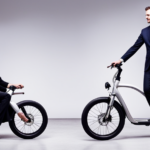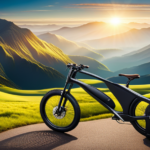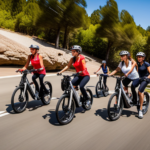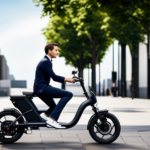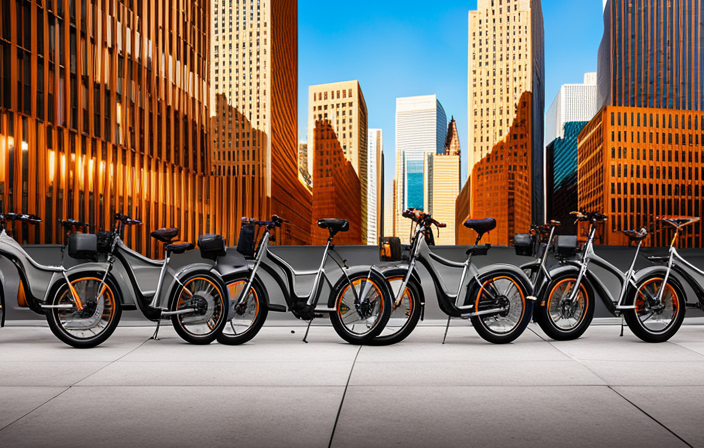Did you know that the global electric bike market is projected to reach a value of $38.6 billion by 2025?
With the rising popularity of electric bikes, it’s important to know how to choose the right one for you. This article will guide you through the process, providing valuable tips and insights.
From determining your riding style and needs to evaluating motor and battery performance, we’ll cover all the key factors to consider.
So, let’s dive in and find the perfect electric bike for your lifestyle!
Key Takeaways
- Prioritize comfort and ergonomics, considering posture, handlebar comfort, and adjustable seat height and handlebars.
- Look for additional features and accessories such as integrated lights, reflective accents, alarms, racks, baskets, fenders, and smartphone integration.
- Conduct thorough research and comparison of battery life, motor power, pedal assist system, pricing, brands, and models.
- Test ride different electric bikes to ensure proper fit, comfort, and compare performance and handling. Also, consider after-sales support and warranty coverage.
Determine Your Riding Style and Needs
To choose the right electric bike, you need to determine your riding style and needs. This step is crucial because it will help you narrow down your options and find the perfect bike for you.
First, consider your sizing options. Electric bikes come in various sizes, so it’s important to choose one that fits you well. Take into account your height and leg length to ensure a comfortable riding experience.
Next, think about your maintenance requirements. Different bikes may have different maintenance needs, so it’s essential to consider how much time and effort you’re willing to put into maintaining your bike.
Once you’ve determined your riding style and needs, you can move on to the next section about considering your budget. It’s important to find a balance between quality and affordability when choosing an electric bike.
Consider Your Budget
When considering your budget, you should take into account your financial limitations. Analyzing affordability is an essential step in choosing the right electric bike.
Start by exploring price considerations, such as the cost of the bike itself, maintenance expenses, and potential future upgrades. Electric bikes can range in price from a few hundred to several thousand dollars, depending on factors like brand, features, and quality. Keep in mind that while a higher price tag may offer more advanced technology and better performance, it may not always be necessary for your specific needs.
Understanding the different types of electric bikes will further guide your decision-making process. Transitioning into the next section, it’s important to consider the various options available to you.
Understand the Different Types of Electric Bikes
Explore the different types of electric bikes available to understand which one best suits your needs. When it comes to choosing the right electric bike for your terrain, it’s important to consider the different options and their pros and cons. Here are three common types of electric bikes:
| Type | Pros | Cons |
|---|---|---|
| Mountain e-bikes | Great for off-road adventures and steep terrains | Heavier and bulkier |
| Folding e-bikes | Compact and easy to store or transport | May have limited range and less powerful motors |
| Commuter e-bikes | Ideal for urban environments and daily commuting | Less suitable for rough terrains and long distances |
Each type has its own advantages and drawbacks, so it’s crucial to choose based on your specific needs and preferences. Now that you have a better understanding of the different types of electric bikes, let’s move on to evaluating the motor and battery performance in the next section.
Evaluate the Motor and Battery Performance
Take into consideration the motor and battery performance to ensure they meet your specific needs and preferences.
When it comes to motor performance, evaluate the power and torque it offers. A high-powered motor provides better acceleration and performance. A motor with higher torque helps you tackle steep hills and rough terrains effortlessly.
Additionally, consider the battery life of the electric bike. Look for a battery that can provide enough range to cover your desired distance without frequent recharging. A longer battery life allows you to enjoy longer rides without worrying about running out of power.
Now, let’s move on to the next section and check the range and charging time to further narrow down your options.
Check the Range and Charging Time
To make an informed decision about which electric bike best suits your needs, it’s important to consider the range and charging time. The range refers to the distance you can travel on a single charge, while the charging time is the duration it takes to fully recharge the battery. These two factors are crucial as they determine the convenience and usability of the electric bike. Factors that affect the range and charging time include the battery capacity, motor power, terrain, rider weight, and speed. It’s essential to find a balance between the range and charging time that aligns with your usage requirements. To help you visualize this, consider the following table:
| Electric Bike Model | Range (Miles) | Charging Time (Hours) |
|---|---|---|
| Model A | 40 | 4 |
| Model B | 60 | 6 |
| Model C | 30 | 3 |
| Model D | 50 | 5 |
| Model E | 45 | 4.5 |
Considering the range and charging time is crucial, but it’s also important to look at the bike’s weight and size, which we’ll discuss in the next section.
Look at the Bike’s Weight and Size
Consider the weight and size of the bike when making your decision. The bike’s weight is an important factor to consider as it will affect your overall riding experience. A lighter bike will be easier to maneuver and handle, especially when navigating through tight spaces or carrying it up stairs. On the other hand, a heavier bike may provide more stability and durability, but it can be more challenging to transport and may require more effort to pedal.
In terms of size, you’ll want to ensure that the bike fits you properly and provides a comfortable riding position. A bike that is too small or too large can lead to discomfort and even potential injuries. So, take the time to find the right balance between weight and size to ensure an enjoyable and safe ride.
Now, let’s assess the bike’s frame and build quality.
Assess the Bike’s Frame and Build Quality
The bike’s frame and build quality are important factors to evaluate when making a purchasing decision. When considering an electric bike, it’s crucial to assess its durability and the material used for the frame. A sturdy frame ensures the bike can withstand the rigors of daily use and provides a comfortable riding experience. Different frame materials offer varying levels of strength, weight, and cost. For instance, aluminum frames are lightweight and resistant to corrosion, while carbon fiber frames are even lighter but more expensive. To help you make an informed choice, here is a table comparing the most common frame materials:
| Frame Material | Durability | Weight | Cost |
|---|---|---|---|
| Aluminum | High | Medium | Low |
| Steel | Very High | High | Low |
| Carbon Fiber | Medium | Very Low | High |
Assessing the bike’s frame and build quality is crucial, but it’s also important to examine the suspension and braking system. [Transition sentence to subsequent section]
Examine the Suspension and Braking System
When it comes to choosing the right electric bike, assessing the bike’s frame and build quality is crucial.
But now, let’s delve into another important aspect to consider: the suspension and braking system. These two components can greatly impact your riding experience and safety.
When examining suspension options, you’ll find a variety of choices, from front suspension forks to full suspension systems. Each option offers different levels of comfort and control, so it’s essential to choose one that suits your riding style and terrain.
In terms of braking technology, electric bikes often come equipped with disc brakes, which provide excellent stopping power and are less affected by wet conditions. Look for features like hydraulic disc brakes for even better performance and reliability.
To summarize, the suspension and braking system of an electric bike play a significant role in your overall riding experience.
Now, let’s move on to the next section and consider the bike’s comfort and ergonomics.
Consider the Bike’s Comfort and Ergonomics
To ensure a comfortable and ergonomic riding experience, it’s important to prioritize the comfort and ergonomics of the bike you’re looking at. When considering the bike’s comfort, pay attention to its posture and handlebar comfort. The bike’s posture should allow for a natural and relaxed riding position, preventing strain on your back and neck. Look for a bike with an adjustable seat height and handlebars that can be adjusted to suit your preferred riding position. Additionally, consider the handlebar comfort. Look for handlebars that are not too wide or narrow, providing a comfortable grip and allowing for easy maneuverability.
To help you visualize the importance of comfort and ergonomics, take a look at the table below:
| Comfort and Ergonomics Features | Benefits |
|---|---|
| Adjustable seat height | Allows for a customized riding position |
| Adjustable handlebars | Provides comfort and reduces strain on the upper body |
| Comfortable grip handlebars | Enhances control and minimizes hand fatigue |
By prioritizing these comfort and ergonomic features, you’ll ensure a pleasant and enjoyable riding experience. Now, let’s move on to the next section and look for additional features and accessories that might suit your needs.
Look for Additional Features and Accessories
Now that you’ve considered the bike’s comfort and ergonomics, it’s time to delve into the world of additional features and accessories.
When choosing the right electric bike, it’s important to look for those extra touches that can enhance your riding experience. Many electric bikes come with a range of additional safety and convenience features that can make your journeys even more enjoyable.
In terms of safety, you might want to look for features such as integrated lights, reflective accents, and even built-in alarms. These can help to keep you visible and alert on the roads.
On the convenience side, features like racks, baskets, and fenders can make carrying cargo and staying dry a breeze. Some bikes even come with smartphone integration, allowing you to track your rides and access navigation without having to pull out your phone.
Now that you’re equipped with knowledge about the additional features and accessories to consider, it’s time to dive into the next step: researching and comparing different brands and models.
Research and Compare Different Brands and Models
To find the best electric bike for you, start by researching and comparing different brands and models available in the market. Comparing features is crucial in determining which bike will meet your specific needs. Some important features to consider include battery life, motor power, and the type of pedal assist system.
Additionally, take the time to conduct a pricing analysis to ensure you’re getting the best value for your money. Look for bikes that offer a good balance between price and performance. By thoroughly comparing different brands and models, you can narrow down your options and make an informed decision.
Once you have compared the various bikes available, it’s time to read reviews and seek recommendations to gather more insights and make a well-rounded decision.
Read Reviews and Seek Recommendations
Consider reading customer reviews and asking for recommendations from others who have experience with different brands and models to gain valuable insights and make an informed decision.
Reading customer reviews can provide you with firsthand information about the performance, durability, and overall satisfaction of electric bikes. Look for reviews that highlight both the positives and negatives of each bike, as this will give you a more balanced perspective.
Additionally, asking for recommendations from friends, family, or online communities can help you discover lesser-known brands or models that may suit your needs.
Once you have gathered this information, you can move on to the next step of test riding different electric bikes to get a feel for their performance.
Test Ride Before Making a Purchase
Before making a purchase, it’s important to test ride different e-bikes to get a feel for their performance. This step is crucial because it allows you to determine if the bike fits you properly and meets your specific needs.
Here are some reasons why test riding is beneficial:
-
Importance of proper bike fitting: Test riding allows you to assess if the bike’s frame size, handlebar height, and seat position are suitable for your body type and riding style. A well-fitted bike ensures comfort and reduces the risk of injuries.
-
Benefits of trying out different models: Each electric bike model offers unique features and riding experiences. Test riding different models gives you the opportunity to compare their acceleration, handling, and overall performance, helping you make an informed decision.
By test riding, you can ensure that the electric bike you choose is the perfect fit for you.
Once you have found a bike that meets your requirements, it’s essential to check the warranty and after-sales support to ensure a worry-free ownership experience.
Check the Warranty and After-Sales Support
Before you make your final decision on purchasing an electric bike, there is one crucial step you shouldn’t overlook: checking the warranty and after-sales support.
A warranty can provide you with peace of mind knowing that your investment is protected against any manufacturing defects or malfunctions. Look for a company that offers a comprehensive warranty coverage, including both the frame and the electrical components.
Additionally, consider the availability of customer service support. You may encounter issues or have questions about your electric bike, and it’s essential to have responsive and helpful customer service representatives who can assist you promptly. Make sure to check if they have a dedicated hotline or email support for customer inquiries.
By considering the warranty coverage and customer service availability, you can ensure that you’ll have a reliable support system throughout your electric bike ownership.
Now, armed with this knowledge, you can move on to the next section and make an informed decision based on your research and preferences.
Make an Informed Decision Based on Your Research and Preferences
Once you have thoroughly researched and determined your preferences, it’s time to make an informed decision on the electric bike that best suits your needs. To help you with this process, consider using different research methods and taking into account your personal preferences.
Research methods can include reading customer reviews, watching video reviews, and comparing specifications and prices of different electric bikes. This will give you a better understanding of the options available and help you narrow down your choices.
In addition to research, it’s important to consider your personal preferences. Think about factors such as the type of terrain you will be riding on, the distance you plan to travel, and your desired level of assistance from the electric motor.
To make the decision-making process more enjoyable, use the following table to compare different electric bikes based on your research and preferences:
| Electric Bike | Specifications | Price | Customer Reviews |
|---|---|---|---|
| Bike A | Specs A | $X | 4.5/5 |
| Bike B | Specs B | $Y | 4/5 |
| Bike C | Specs C | $Z | 3.5/5 |
By considering both research methods and personal preferences, you can make a well-informed decision and choose the right electric bike for you.
Frequently Asked Questions
How often should I expect to replace the battery on an electric bike?
On average, you can expect to replace the battery on an electric bike every 2-4 years. However, the battery lifespan can be influenced by several factors.
The type and quality of the battery, how often you use the bike, the terrain you ride on, and the weather conditions can all impact the longevity of the battery. Proper maintenance, such as charging and storing the battery correctly, can help extend its lifespan.
Are there any maintenance requirements specific to electric bikes?
Maintenance tips are crucial for keeping your electric bike in top shape. Common issues include battery maintenance, tire pressure, and chain lubrication.
To ensure your e-bike runs smoothly, regularly check the battery for wear and tear, and replace it as needed.
Keep an eye on tire pressure to prevent flats, and regularly lubricate the chain to avoid rust and improve performance.
Staying on top of these maintenance tasks will ensure a long-lasting and reliable electric bike.
Can I use an electric bike in all weather conditions?
Yes, you can use an electric bike in all weather conditions. One of the advantages of electric bikes is their versatility. They are equipped with waterproof and weather-resistant components, allowing you to ride them in rain, snow, or shine.
However, there are some disadvantages to consider. Wet or icy conditions can affect traction and control, so it’s important to ride cautiously. Additionally, extreme temperatures can impact battery performance.
Overall, electric bikes are suitable for various weather conditions, but riders should exercise caution and be prepared for any challenges that may arise.
What safety precautions should I take when riding an electric bike?
When riding an electric bike, safety should be your top priority. To ensure a safe ride, it’s crucial to wear appropriate riding gear such as a helmet, gloves, and knee pads.
Additionally, important accessories like lights and reflectors help increase your visibility, especially when riding at night. Remember to follow traffic rules, stay alert, and be cautious of your surroundings.
Taking these safety precautions will help you enjoy a secure and worry-free ride on your electric bike.
Are there any legal restrictions or regulations for electric bike usage in my area?
When it comes to electric bike usage, it’s important to be aware of the legal implications and local regulations in your area. Different regions have varying laws regarding speed limits, age restrictions, and where you can ride your electric bike.
Familiarize yourself with these regulations to ensure you are riding within the boundaries of the law. Contact your local transportation or motor vehicle department for specific information on electric bike regulations in your area.
Conclusion
In conclusion, choosing the right electric bike requires careful consideration of your riding style, needs, and budget. Understanding the different types of electric bikes and evaluating their motor and battery performance is crucial.
Checking the range and charging time, reading reviews, and seeking recommendations will help you make an informed decision. Don’t forget to test ride before purchasing and check the warranty and after-sales support.
By conducting thorough research and considering your preferences, you can find the perfect electric bike that fits your lifestyle and enhances your riding experience.


